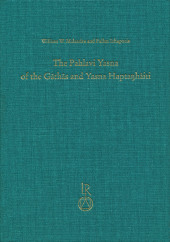 Neuerscheinungen 2013Stand: 2020-01-07 |
Schnellsuche
ISBN/Stichwort/Autor
|
Herderstraße 10
10625 Berlin
Tel.: 030 315 714 16
Fax 030 315 714 14
info@buchspektrum.de |

Pallan Ichaporia, William W. Malandra
(Beteiligte)
The Pahlavi Yasna of the Gathas and Yasna Haptanhaiti
2013. 264 p. 24 cm
Verlag/Jahr: REICHERT 2013
ISBN: 3-89500-968-7 (3895009687)
Neue ISBN: 978-3-89500-968-6 (9783895009686)
Preis und Lieferzeit: Bitte klicken
The Pahlavi Yasna of the Gathas and Yasna Hapta haiti is a critical edition of the Pahlavi text, with citations of parallel passages in the D nkard, accompanied by a complete glossary and an introductory text-critical treatment of the text. Also provided is a parallel Avestan and Pahlavi text designed to portray the near word-by-word dependence of the gloss on the original Avestan. Owing to the very nature of the Pahlavi gloss, which itself is not a translation, no English translation is attempted.
As the title suggests the book is a study of the Pahlavi Yasna, a Middle Persian (Pahlavi) gloss on the liturgical text, the Yasna. The study is restricted to the Gathas or Hymns of Zarathustra (Zoroaster) and to the Yasna Hapta haiti, a prose text composed in the same dialect of Avestan. There are three main sections: Introduction, The Text, and Glossary. In addition there are two Appenices: I Parallel Text of the Avestan and Pahalvi Gloss; II The as m vohu and its Variants in the D nkart. The Introduction is a text-critical study of the Pahlavi Yasna which addresses the main issues of the nature of the text, its authorship and dating, and its relationship to parallels in the D nkard. In the presentation of the text, the position is taken that the fundamental text is a nearly word-by-word gloss on the original Avestan. That is, it is not a translation as we might understand the term. Interspersed in the gloss are miscellaneous comments inserted by later hands to illuminate certain words and passages. Appendix I is provided to portray how the glosses line up with the Avestan, ignoring the later comments. The text itself is based on the 1946 critical edition of B. N. Dhabhar given in the Pahlavi script and to which we have provided many improvements. In footnotes we have cited all the parallel passages from the D nkard. These reveal that there were exegetical traditions other than the official Pahlavi Yasna. Although Dhabhar´s edition included a glossary, it is not up to the philological standards of current scholarship. There is deliberately no translation into English, as a running gloss of this sort does not lend itself to a coherent translation.
The contribution to the fields of Middle Persian and Zoroastrian studies is really threefold: 1) to establish a reliable text in Roman transliteration; 2) to provide an extensive glossary of all lexical items; 3) to contribute to an understanding of the nature and formation of the text. The intended readership is primarily scholars and students who have some acquaintance with Pahlavi and have an interest in the history of Zoroastrianism.


